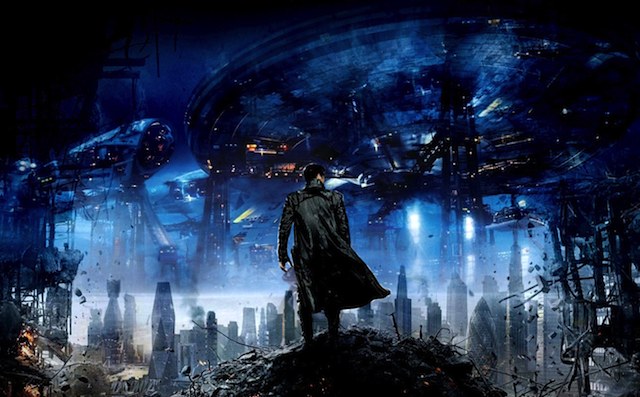Before we start I want to say this about Star Trek Into Darkness: I’ve seen it in both 3D and 2D, and I urge you not to waste your money on a 3D ticket. Seriously, there is nothing in this movie that requires 3D, and it does bupkuss to enhance the experience.
Mind you, this movie is a visual feast, but 3D doesn’t really add anything to the feast except for maybe that piece of parsley that is used as a garnish that you throw away and never eat.
Enough of the tortured food metaphor. I went into STID with very low expectations. As I’ve said in the past, Star Trek is not at its best in movie format, especially in our post-Star Wars world where science fiction movie must equal BIG-ASS ’SPLOSIONS! in order make its box office requirements. At its best, Trek is about the exploration of the human condition, something not remotely on display in either of J.J. Abrams’s films. I figured we’d get what we got four years ago: a visual feast (as long as you don’t mind lens flares), excellent acting, and a script that doesn’t hold together upon scrutiny. My expectations were, sadly, met.
If you want a spoiler-free review, Tor.com’s own Chris Lough wrote an excellent one here. For this review THERE BE SPOILERS HERE!!!! LOTS OF ’EM!
Let’s cover the good stuff first. The movie is fun. Even when it’s at its heaviest (the Harewood family, Pike’s death, Khan’s anguished expository monologue), it never loses sight of the fact that it’s an adventure story. The pace is excellent—the two-and-a-half hours just zip on by—and the script keeps a light touch.
The acting here is first-rate. As with the previous film, the actors embody the characters they’re playing without spilling over into parody. In particular Chris Pine and Zachary Quinto do an excellent job with characters who are both the same and different from their alternate-timeline counterparts played by William Shatner and Leonard Nimoy, because Kirk and Spock are the characters who were most changed by Nero’s time-travel shenanigans in the last film—the former lost his father, the latter lost his world.
Okay, side note here: the myth that Kirk is a rebel who follows his own path and breaks all the rules is just that, a myth. If you actually watch the original series, Kirk in fact regularly obeyed orders, consistently followed the rules—a notable exception being in “Amok Time,” and even then he was forgiven by T’Pau stepping in. Kirk’s maverick rep is entirely an artifact of the movies, especially The Search for Spock—again, Kirk only breaks the rules when his best friend’s life is at stake.
Anyhow, I mention this because Pine’s Kirk is way more of a rule-breaker than Kirk ever was even in other feature films, and I like the way Pine plays him. The Kirk we knew is in there somewhere, but it’s underneath the angry kid who grew up without a father. (It wouldn’t be a J.J. Abrams film if at least one of the characters didn’t have Daddy issues, after all.)
As for Spock, he goes on a nice character journey here, albeit one with a rather sudden resolution. In the opening scene on Nibiru (about which more in a bit), he pretty obviously has a death wish. He’s practically begging the volcano to eat him. But then he mind-melds with Admiral Pike as the latter dies, and he later admits that he doesn’t want that. And then—well, that’s it, really. I would’ve liked the arc to have completed itself in a manner other than Spock talking about it to Uhura and Kirk in the trading ship. But then, there’s another arc he has to go on after that—which, again, we’ll get to.
Either way, though, Quinto is superb, channeling the Leonard Nimoy of forty-five years ago while making it his own. He’s joined by a strong supporting cast: John Cho is a rock, Zoe Saldana is solid, Karl Urban is criminally underused (but, like DeForest Kelley before him, recipient of many of the best lines and is a master curmudgeon), and Anton Yelchin does the best he can with what he has to work with.
But the standouts here are Simon Pegg as Scotty and especially Benedict Cumberbatch as “John Harrison,” who is soon enough revealed to be Khan Noonien Singh.
Pegg is a delight here, taking the ridiculousness of the Scotty character and embracing it. He resigns on a principle, and it’s a good one, but still comes through to help Kirk and save the day later on. Pegg is a great verbal and physical comedian, and those skills shine through without ever losing sight of Montgomery Scott’s skills and importance to the ship.
But the movie is utterly stolen by Cumberbatch. And it’s not even close. He’s surrounded by some pretty high caliber actors, and Cumberbatch makes them look like a high school repertory company. He absolutely sells every element of Khan—his intelligence, his anger, his passion, his calculation, his fury, his strength, his skill. When he announces to Kirk that he’s “better” at “everything,” it includes acting. Hell, he does more with an intense gaze at Kirk through a window just before he beams to Kronos than anyone else is able to do in the whole movie.
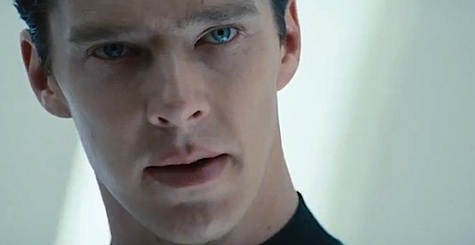
(A friend pointed out how impressive Martin Freeman is that he doesn’t let Cumberbatch so completely steal every scene on Sherlock the way he gets away with here.)
I especially like that, while we get a revenge-obsessed Khan à la The Wrath of Khan, the version of Khan that Cumberbatch is playing is much closer to the younger Khan we met in “Space Seed.” He’s more subtle, more conniving, more of a long-term planner. (For all that they spoke of his intelligence in Wrath, he was a lot more reactive and not at all complex.)
The movie is also very pretty, with some stellar visuals. As an added bonus, the Enterprise design didn’t piss me off as much this time (they used Livermore Labs for engineering instead of a brewery, which helped), though the lens flares really have to go.
If only the script actually made sense…
Okay, we start with the Nibiru mission, which is a) the only part of the movie that feels like Star Trek and b) has absolutely nothing to do with the rest of the film. I would much rather have seen a movie that dealt entirely with Nibiru, establishing the culture, seeing the process by which the crew decided to neutralize the volcano, and then dealing with the consequences of the natives seeing the Enterprise (beyond a fobbed-off joke scene). For starters, that would’ve actually been a Star Trek movie…
Also, why is the Enterprise hiding underwater? Seriously, on what planet does that make a lick of sense? They have transporters, and they don’t want to risk the natives seeing the ship, so why not just keep the ship in orbit where it’s in no danger of being seen? (Because then we wouldn’t get the cool shot of the Enterprise coming out of the ocean.)
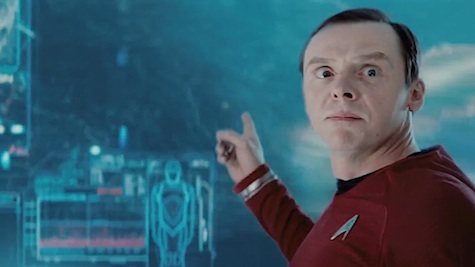
And then Spock objects to them coming out of the water to rescue him because it would violate the Prime Directive. Except for one problem—just a few scenes later, Pike is reaming Kirk and Spock out for both fixing the volcano and letting the natives see the ship. In fact, Pike seems to think that the volcano tampering is the worse violation—though I think he’s more pissed that Kirk kept it out of the report than anything. Still, if they’re both regs violations, why did Spock start getting all persnickety about being rescued being against regs when the very reason he was in the volcano in the first place was as big a violation of those regs?
Kirk is then demoted to commander, with Pike given the Enterprise back, and Spock transferred to the Bradbury. This might be a really cool development, except it only lasts for six-and-a-half seconds, as Pike is killed, Kirk is given his ship and his rank back, and Spock’s back by his side. What was the point of that whole thing if it’s not actually going to matter?
Meanwhile, we meet “John Harrison” who convinces Mickey Smi— er, that is, Lieutenant Harewood to be a suicide bomber in exchange for Harrison using his magic blood to cure his ill daughter. (For all that the magic blood is the stupidest thing ever, at the very least they put that gun on the mantelpiece right there in the early part of the movie, so we know what the deus ex machina will be.) Points, by the way, to Noel Clarke and Nazneen Contractor, who sell the Harewoods’ anguish just with facial expressions and body language.
Harrison then fires on the meeting of high-ranking officers that always happens when someone blows up a building on Earth. He fails to kill Admiral Marcus, though Pike is killed, and he then uses the magic plot-device long-range transporter that Scotty created in the previous movie because the plot needed to get Kirk back onto the Enterprise. This time it’s used to let Harrison escape to the Klingon homeworld, which he does for no reason that the script bothers to explain. Sure, it’s a place where Starfleet can’t follow, but doing so actually plays into Admiral Marcus’s eeeeeevil scheme to start a war. So why didn’t he go somewhere else? Romulus? Some faraway planet where he could live to scheme another day? Or, at the very least, a planet that wasn’t inhabited with people who wanted to kill him?
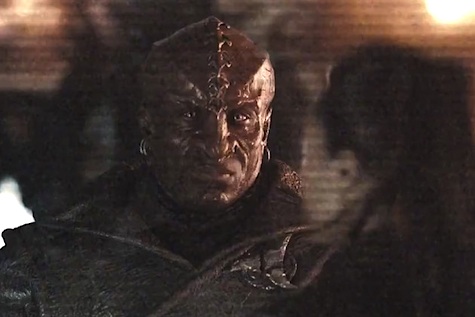
Scotty then resigns rather than allow the classified torpedoes that he can’t scan into his engine room. Kirk accepts the resignation and puts poor Chekov in charge of the engines, only to come around to Scotty’s (and Spock’s) POV on the mission and deciding not to use the torpedoes that Scotty refused to have on board. So why let him go? (The reason, of course, is because the plot needs Scotty to go to Jupiter and find the Vengeance.)
Skipping over the absurdity of Klingons with helmets (they have cranial ridges, wearing a helmet is like giving Superman brass knuckles),* we then go to Khan’s surrender, enabling him to play Hannibal Lecter for a bit before Kirk needs his help against the Vengeance—a ship that Admiral Marcus has managed to create all on his own, with help from Khan, whom he found shortly after Vulcan was destroyed.
Marcus’s conspiracy is maddeningly vague. Did he do this by himself? That’s not really possible, so how did it gain so much traction? How many other ships like the Vengeance are there? If there’s just the one, it’s not much of a conspiracy, really. Who else in Starfleet is involved? Plus, Marcus himself is missing only a mustache to twirl. His third-rate Jack Nicholson speech to Kirk on the bridge is embarrassingly bad, and the moment where Khan crushes Marcus’s head is something of a relief, because as a bad guy, Khan’s obviously the more interesting one. (Peter Weller is usually better than this.)
And then we have the Parade Of Endless Action Set Pieces. I actually rather liked Kirk and Khan rocketing through space from the Enterprise to the Vengeance, though the debris field was a little too full given the duration of the battle and the damage to the Enterprise, and the scene went on a hair too long—a perpetual problem, as the Kirk-fixes-engineering-and-dies scene and the Vengeance-crashes scene, and especially the Khan-Spock-chase-and-fight-on-the-big-red-thingies-that-only-seem-to-exist-so-people-can-have-airborne-fistfights-on-them scene are also waaaaaay too long.
The script is choked with fan-service, starting with the choice in villain, and extending to quoting/referencing the previous movie that villain was in over and over and over again. Pretty much none of these work. Quoting “the needs of the many outweigh the needs of the few” just makes the Nibiru scene that much more annoying. The insertion of Dr. Carol Marcus into the narrative is beyond forced, and totally unnecessary except as that tiresome fan-service—only it doesn’t work, as the character Bibi Besch played wasn’t a weapons expert (in fact, her objections to the weaponizing of Project: Genesis is a major plot point)—and also to have a gratuitous shot of Alice Eve in her underwear. (I freely admit to enjoying the latter as a heterosexual male, but it really was spectacularly gratuitous.) But the plot wouldn’t be any different if the admiral and doctor weren’t named Marcus, and it’s a pointless callback.
Reversing the death scene from The Wrath of Khan was cute-ish, but mostly just annoying, especially since Khan apparently stepped outside for a cigarette while this was going on, as this lengthy repair/death scene goes on while the Vengeance does nothing.
And then Spock shouts, “Khaaaaaaaaaaaaaaaaaaaaan!” The first time I saw STID, it was in a packed midtown theatre on the preview night. That crowd cheered when “Harrison” announced that he was actually Khan, so this was an audience that was right there with the filmmakers on this.
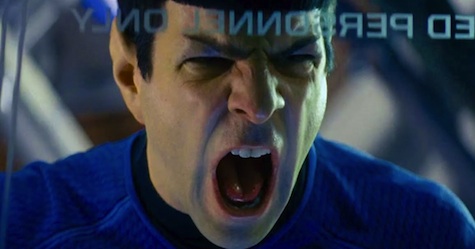
They all laughed when Quinto did his Shatner impersonation. I just rolled my eyes. It was a ridiculous moment.
This is made infinitely worse by the use of Khan’s magic blood to revive Kirk, thus making his sacrifice even more pointless. And it also gives us a resolution between Kirk and Spock that tries to paint their friendship as being as strong as it was in the other timeline, but that friendship had decades to build. Hell, it was already in place when we first meet them in “Where No Man Has Gone Before” (they’re playing chess and Spock is calling the captain “Jim,” they’re already friends), and the bond deepens over the course of two TV series and a couple of movies, so that when Spock dies in The Wrath of Khan, of course it affects Kirk. But Kirk and Spock don’t have anything like that kind of bond yet, indeed, they pretty much have the opposite of one. The entire sickbay scene after Kirk is resurrected by magic blood (I assume Augment blood will become standard issue in Federation hospitals going forward?) falls completely flat because the relationship isn’t convincing.
(Oh yeah, one more thing about the magic blood. If Khan has it, wouldn’t the other 72 guys have it? Why did McCoy need Khan when he had 72 other sources of magic blood right there in his sickbay?)
Some of the fan-service worked. Pine is given two redshirt jokes that work beautifully, especially the first thanks to Yelchin’s pained response. There are two references that are straight out of Deep Space Nine, one obvious (Section 31), the other less so (Ketha, the uninhabited region where Khan takes refuge is also the region where DS9’s Martok comes from). And K/S slash fans must have loved the scene where Carol Marcus reports to Kirk, and Spock acts for all the world like a jealous girlfriend. There are shoutouts to Daystrom (from “The Ultimate Computer”), the Kelvin (from the 2009 film), and the Gorn (from “Arena”), as well as cameos by a tribble and, oh yeah, the mainline Spock, who breaks his own promise to warn his younger self about Khan in a surprise Leonard Nimoy cameo.
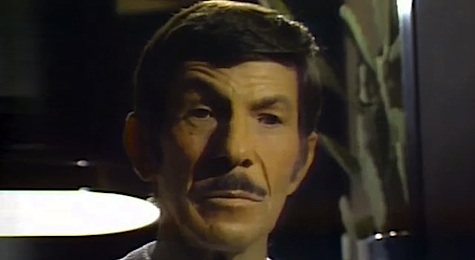
The Spock-Uhura relationship is still going full bore, albeit with some bumps. I never had a problem with this particular pairing, and anyone who thinks it’s dumb or pulled out of their asses is instructed to go watch “Charlie X” again, with particular note of the mess hall scene where Uhura’s singing. It also provides some of the comedy in the film, particularly Kirk and Uhura’s turbolift conversation on the subject of their relationship strife. (“Are you guys fighting? What is that even like?”)
That midtown theatre crowd I mentioned before enjoyed the hell out of the movie, as did the smaller crowd I saw it with Sunday night. It would’ve been nice if it was a smart movie, but that’s obviously too much to hope for, so we must settle for a romp. It’s a good romp, as romps go, and it’s keeping Star Trek popular after a decade of bad TV shows and bad movies, so I can’t complain all that much. STID is doing what Star Trek did four years ago: making Star Trek enjoyable and popular again.
And hey, maybe next time, we’ll get a script that makes sense.
*There’s also the shattering Klingon moon that’s colliding with the surface of Kronos, which is just weird. Is that supposed to be Praxis, exploding a good couple decades too early? Yet another element where the emphasis was on what looked cool rather than what served the story.
Keith R.A. DeCandido did the Star Trek: The Next Generation Rewatch for this very web site from 2011-2013, and has since moved on to a Star Trek: Deep Space Nine Rewatch, which runs here on Tor.com every Tuesday and Friday. He’s written a metric butt-load of Trek fiction, including more than a dozen novels, a tremendous amount of short fiction, a few comics books, some magazine articles, and more. And he’s written tons of other stuff, too. Read his blog, follow him on Twitter, friend him on Facebook, listen to his podcast. You’ll be glad you did.










